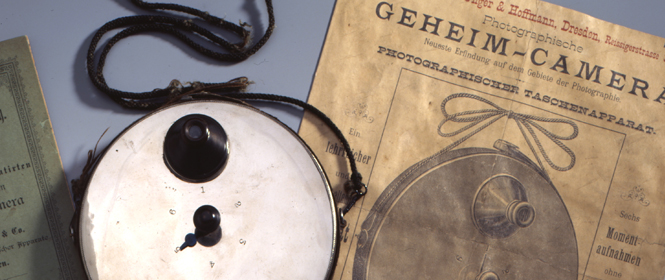
The camera beneath the jacket
Everyone’s talking about surveillance and espionage by secret service agencies and the media. A secret camera in our “What’s that for?” series pays testament to the fact that state surveillance was common practice in Germany in the late 19th century.
The secret camera, which was made in 1886, is round, has a diameter of 15 centimetres and is flat enough to be discreetly concealed beneath a jacket. The lens is designed to peep out through a buttonhole. Next to the lens is a knob for adjusting the exposure; the user could also reset the shutter release by repeatedly turning the dial. The shutter was released by pulling a cord on the side. The fact that the film could only hold a maximum of six photos, however, raises the question of what this miniature secret camera was meant to be used for.
Cutting-edge technology in the fight against enemies of the state
The secret camera was developed in the era of the Anti-Socialist Laws (“Sozialistengesetze”). German Chancellor Bismarck attributed two failed assassination attempts on Germany’s first Kaiser, William I, in 1878 to the Social Democrats. On 19 October, he managed to persuade the Reichstag to pass the “Gesetz gegen die gemeingefährlichen Bestrebungen der Sozialdemokratie” (“Law against the public danger of Social Democratic endeavours”), which banned socialist groups, meetings and literature. In order to keep tabs on the activities of the Social Democrats, police officers made use of cutting-edge technology, such as this camera made in 1886. Prohibition and surveillance, however, were not enough to prevent Social Democrat MPs from being elected to the Reichstag. In 1890, relations broke down between William II and Otto von Bismarck – with the latter forced to resign. The Anti-Socialist Laws were also scrapped in 1890.